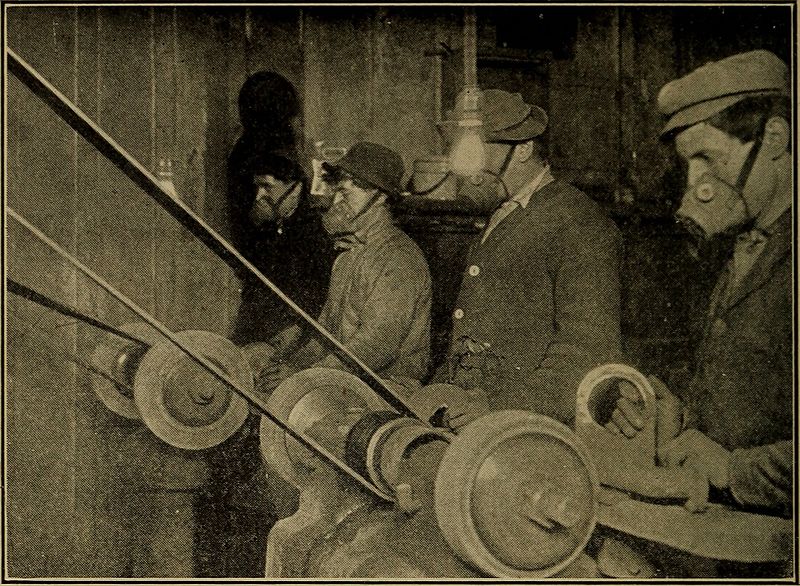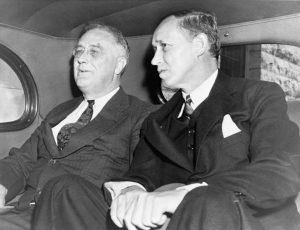For the average American, having a job is an essential aspect of life; without a stable source of income, it is nearly impossible to survive in today’s world. Working during the 1900’s was not as easy it may seem at first look. Although it is true that there were many new jobs available in factories, working in them posed many significant consequences for the employees. Working was more difficult than expected, Americans suffered from working extreme hours around heavy machinery, which made fatalities skyrocket. The government did eventually pass labor laws, but it could not undo the difficulties people had faced.
These laws were meant to maintain the health of workers while providing them safety and compensation for work-related injuries.1 The working conditions of factories produced many hardships for Americans. The pay was barely enough to feed one mouth, so it was rather impossible to feed a whole family. In today’s society, minimum wage employees complain about getting paid $7.25 per hour, but there was no minimum wage in 1900. The average person today works 40 hours per week, which is $290 per week at minimum wages. Most paychecks are handed out every two weeks; therefore, most Americans can make up to $580 in one paycheck. In 1900, the average American worker was paid a measly $400-$500 over the span of a year; this is less than the typical American makes in one paycheck today. Even adjusted for inflation, a higher percentage of Americans lived in poverty then than they do today.2
Although some people believed that only males should hold jobs, there was actually an increasing number of females and children being employed in the workplace. However, the women and children being hired were typically not prepared for career choice jobs, forcing them to work in factories. Factories took advantage of individuals that would work for lower wages without outcry; more often than not, these individuals were comprised of women and children that were desperate for the opportunity to bring any form of income into the household, not realizing that their lower pay may decrease the pay that the father of the house received.3
By 1900, almost 17 percent of females comprised the industrial workforce, most of whom were single and trying to support themselves, their children, or their siblings.4 The women who typically worked were usually white and tended to be under the age of twenty-five; however, a vast majority of workers were the daughters of immigrants or were immigrants themselves.5
The main workplace for women was in the textile industry; this was because most women could not handle the heavy manual labor like men could. In these factories, women typically were paid wages of $6-$8 per week, causing their average income to fall well below the average wages for men. With such a low paycheck, most women found themselves in poverty, and some were forced with no other option besides prostitution.6. Another issue with women working is that society believed that it was wrong for women to be in the workplace and out of the household; so the women who had to take up a job were scrutinized. This view on women working did change over time, with the majority of communities seeing married, employed women as a strong figure, opposed to being the quiet, nurturing, and delicate character that was expected of them.
Due to such low income, most family members were forced to get jobs. This meant that when the man could not solely support the family, women had to step up. When even this did not produce the amount of money needed to sustain the family, children were next in line to find a job. Children that tended to work were often from families whose husbands denied the right for their wives to work; so they helped provide for the family so their mother did not have to work. At least 1.7 million children under the age of sixteen were employed in factories or fields by 1900. About 10% of girls were the age of 10-16 and boys made up 20% of all ages of employed workers.7 Unlike the wives in the textile industry, most children found themselves working in agriculture for an average of twelve hours a day, performing arduous tasks such as picking and hoeing the fields.8 Children in the South usually worked at night, with employers keeping them awake by throwing cold water in their faces. The majority of female children had to cut fruits and vegetables for sixteen hours a day. Even though laws were passed to protect children, they were still vulnerable to getting severely hurt while working; some of these injuries turned fatal quickly.9

Other hardships Americans faced was the amount of hours that made up a typical working day. Most Americans had to work 10-12 hours, six days a week. If they worked in the steel industry, the typical working day consisted of 12 hours.10 The hours may not have seemed so bad, and many of us may have already worked that long for a shift, but the working conditions they were subjected to at the time made it much more difficult. The conditions were labeled as unfit and unhealthy for humans and working for long, exhausting hours did not help reduce the number of injuries. There were several accidents that ended in tragedy, labeling factories as unsafe for working. Although injuries were common, it was very rare for a victim of these on-the-job injuries to receive any type of compensation from their employers or the government. Eventually, workers lost control of the conditions for their labor. With this loss of control, more problems appeared, including already low wages being lowered further and long hours turning longer.
Having a job was never an easy task to maintain in the past. Through the difficult times, Americans did not give up; they fought through the struggles to create a successful life. In the end, one can say the labor challenges were worth the struggle because over time, the United States has significantly improved the laws that we see enacted today that are used to protect all individuals working, as well as protecting children from being subjected to work at young ages.
- “Labor Laws and Regulations,” Monthly Labor Review 7, no. 4 (1918): 240. ↵
- Alan Brinkley. American History: Connecting with the Past Volume 2, 15 edition (New York, NY: McGraw-Hill Education, 2014), 477. ↵
- Alan Brinkley. American History: Connecting with the Past Volume 2, 15 edition (New York, NY: McGraw-Hill Education, 2014), 477. ↵
- Alan Brinkley. American History: Connecting with the Past Volume 2, 15 edition (New York, NY: McGraw-Hill Education, 2014), 477. ↵
- Alan Brinkley, American History: Connecting with the Past Volume 2, 15 edition (New York, NY: McGraw-Hill Education, 2014), 477. ↵
- Alan Brinkley, American History: Connecting with the Past Volume 2, 15 edition (New York, NY: McGraw-Hill Education, 2014), 478 ↵
- Alan Brinkley, American History: Connecting with the Past Volume 2, 15 edition (New York, NY: McGraw-Hill Education, 2014), 478. ↵
- Edward N. Clopper, “The Federal Child Labor Law,” The Elementary School Journal 17, no. 5 (1917): 327. ↵
- Albert J. Beverage, “Child Labor Laws,” The Journal of Education 68, no. 12 (1908): 330. ↵
- Alan Brinkley, American History: Connecting with the Past Volume 2, 15 edition (New York, NY: McGraw-Hill Education, 2014), 477. ↵



46 comments
Saira Castellanos
I really liked the information in the article, even though i already knew everything because it was taught to me in high school. I kind of had a hard time reading this though. This article seemed more like a research paper for a high school English class. Other than that i really liked this article. Its crazy the change between then and now. I am so glad i dont live in those days because i dont think i am as strong as those people ha to be back then.
Robert Rodriguez
These days we have it easy that we forget how things used to be, looking back at pre-labor law times makes me grateful for those laws and for the progress we have made as a society. This article gave really good information on the topic. its sad that these people were basically forced to work at these places in order to make ends meet. the visuals really helped me create an image in my head to better understand how times were, amazing article!
Andrew Dominguez
Its amazing to think how far we have come in working conditions in America. Blue collar work was part of our history and was often very dangerous. Now the conditions today have improved drastically, yet people don’t want to work this type of work even though jobs are available. What i don’t understand is why women were shamed for working. It shouldn’t matter since they were trying to provide for their families.
Hannah Wilson
The hardships that people faced before labor laws were passed is saddening. They had to withstand hours of hard labor, healthy or unhealthy to provide for their families. The fact that bosses made their workers, women, children, and men undergo horrendous conditions just to make a profit is disappointing and wrong. Seeing the progression of America overtime and all of the advancements and improvements we have made is good. Great Article.
Christopher King
Blue collared jobs during that time were incredibly hard and very low paying in wages. I liked how this article described the downside of manual labor during that time but I would have liked to know the dangers that they faced working in the factories. Things such as the triangle shirt factory fire involved the hardships that those women had as far as pay and working conditions and the danger they faced because they could not be trusted. Then the fact that Henry Ford revolutionized how his laborers were treated and paid.
Destiny Flores
Reading articles such as these just makes me incredibly grateful at how far the progress of the workforce has become. I enjoyed how this article had a lot of facts and how it compares the wages of today to those of the workers of the 1900’s, it helps to imagine the struggle even further. Also, nice use of images. They illustrate the obstacles endured by generations before us and exaggerate even more on the theme.
Angela Rodriguez
I have always heard about the unfair wages back in the 1900s but no one had ever told exactly what were the wages. I found this article to be an interesting read, especially since you incorporated what are today’s wages and workforce. It’s makes me realize how grateful I should be at work, and not be so eager to get a raise.
Troy Leonard
great job on breaking down how people worked back then and the conditions that they lived in. it makes you think, we complain about our jobs and how we are under payed but bac then they were making in a year what we would make in 3 weeks. also their working conditions were horrible and I’m glad that they changed it and made it safe for people to only work in good working conditions because that’s not safe the way they were working.
Josselyn Arrieta-Meraz
The simple recognition on how far this country has come too since the 1900’s and even before is insane. Many immigrants now and in past years came to this country to achieve the American Dream. A dream that consists of freedom of speech and liberty along with many others, but most importantly to those immigrants the idea of success was what brought them to this country. Going back to the 1900’s a time where there was no minimum wage an ideal in which women and children suffered the most. They were trying to survive on such low income in a country that was fastly growing. The fact that this article makes a comparison to common wages being paid at the time, to paychecks an average American receives bi-weekly today really puts this piece of history into perspective. The amount of children being forced to work in order to help their families and the unjustness of salary being paid not only to them but to the women because of their gender allows us to see what our world once was. Many countries were and still are maintained by the work and hard labor of it’s inhabitants, and with the help of laws and regulations anything is possible.
Joshua Breard
The American Dream consists of working hard and being rewarded. Which when thinking about it, it does make sense. However, if we are looking back in the year 1900, there was no minimum wage and someone who worked 40 hours a week. If we are looking at this with Los Angeles’ current minimum wage of $12.50, we are looking at $500 dollars being earned for that week. In comparison to back in 1900, workers are lucky to have earned 400-500 dollars a year. Of course inflation and other economic activity has to be considered when looking at wage now vs.in the year 1900. These low incomes in 1900 meant that various people in the family had to get a job in order for the family to live on their own. Today, some families just need one parent with a good job to be working.